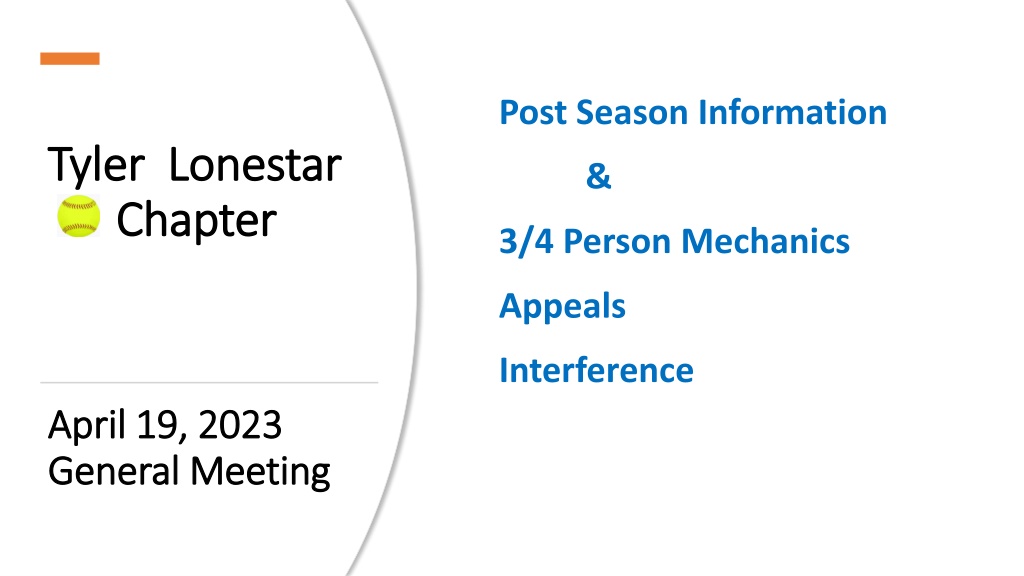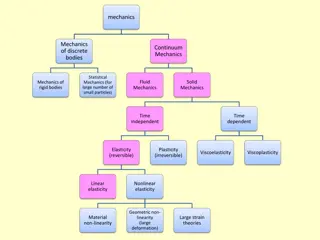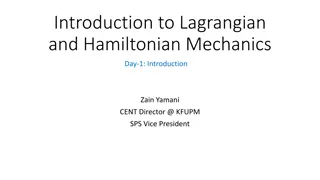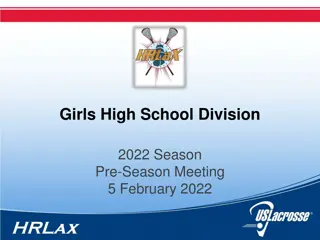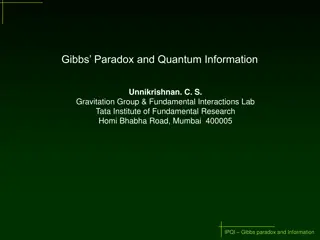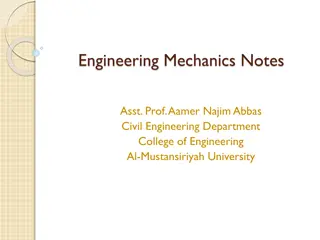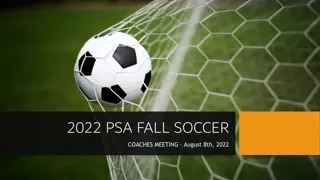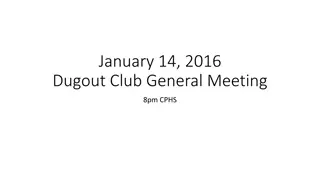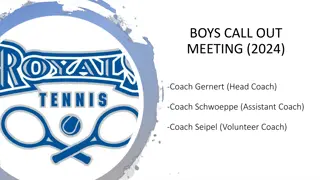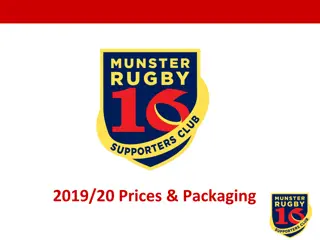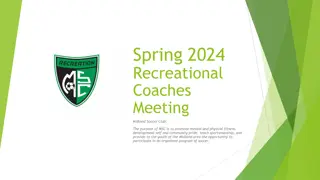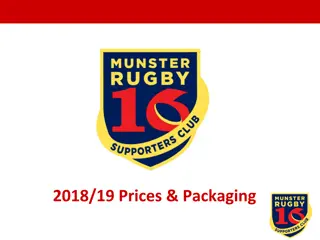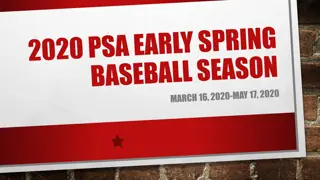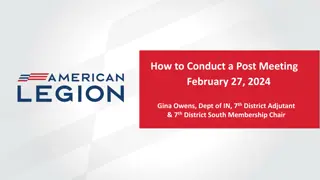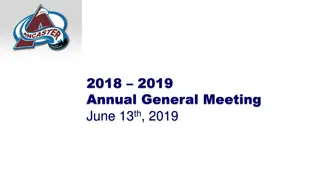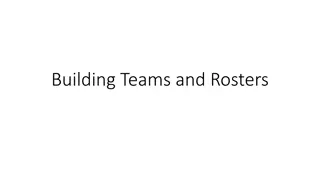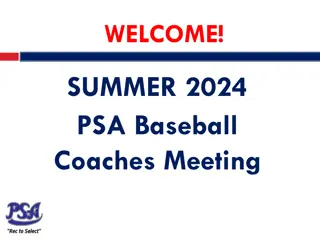Post Season Information & 3/4 Person Mechanics: General Meeting and Congratulations
Learn about post season information, 3/4 person mechanics, appeals, and interference from the General Meeting on April 19, 2023. Plus, congratulations on being selected!
Download Presentation

Please find below an Image/Link to download the presentation.
The content on the website is provided AS IS for your information and personal use only. It may not be sold, licensed, or shared on other websites without obtaining consent from the author. Download presentation by click this link. If you encounter any issues during the download, it is possible that the publisher has removed the file from their server.
E N D
Presentation Transcript
Post Season Information & Tyler Lonestar Tyler Lonestar Chapter Chapter 3/4 Person Mechanics Appeals Interference April 19, 2023 April 19, 2023 General Meeting General Meeting
Congratulations youve made it, you ve been selected to work a post-season contest. Post-Season Information Now what do you do next? Notification
Post-Season Information We have put together the following presentation to alleviate your angst and assist you with being prepared to handle this responsibility. Notification
Post-Season Information First thing to do is to ensure that you are available for the contest and then accept your assignment in Arbiter Notification
Next make sure that your uniform and equipment are ready. If they re not, then get them ready. Remember you might be going a long ways away to work the game(s) be prepared for this. Post-Season Information Uniform & Gear
We wear the following clothing to and from the contests that we officiate in the post-season. Post-Season Information - Chapter Polo Shirt or another color if all crew is the same. Khaki or Black Dress Pants Business Casual Shoes - - Travel Clothes NOTE-- AT NO TIME ARE SHORTS CONSIDERED PART OF THE TRAVEL CLOTHING ATTIRE..
Crew Chief is responsible for: - Contacting your fellow umpires and ensure all of you know.. a. Where your contest is b. When your contest is c. What time you will meet at the contest site d. Whether or not you will ride together e. What travel uniform you will wear Post-Season Information Crew Chief
Crew Chief is responsible for: Post-Season Information Being in contact with the coach(s) in case of weather, other delays or changes to the location or time. If you are already in route to one location and it's changed to another. Chasing fields can become a necessity in the post season get ready for it Crew Chief
Crew Chief is responsible for: Post-Season Information Relaying information to the crew in the most expedient way possible and ensure all are updated. Also make sure the chapter leadership knows what is going on as well. Crew Chief
Crew Chief is responsible for: Post-Season Information Gathering and reviewing pay sheets and W9 s of your crew prior to submitting them to the coach(s) or the Game site administrator depending on how its being run. Crew Chief
Beginning with Warm-Up Games and Play-In Games their will be several changes from the regular season. Post-Season Information Championship Play (Post-Season) 10 Runs after 5 Innings. AT NO TIME WILL YOU COMPLETE A GAME USING THE ITB RULE.. Or any other Run Rule Scenarios TASO Game ending Scenarios
If your game is not complete and is being suspended due to lightning or weather. Crew Chief get with the coaches and remind them to get the information to Chuck and Oscar so that they can ensure the continuation of the game is covered. Post-Season Information TASO Game ending Scenarios
We DO NOT end the games unless there is a clear winner. Games are suspended pending decisions from TASO, and the Schools Involved in the contest. Post-Season Information NO GAME can be protested if a Coach has a question, it must be settled prior to moving forward with the game. TASO Game ending Scenarios and Protests
The pre-game conference will prepare the crew for a successful contest. What should you discuss during this pre- game conference? a. If you are using 3 Person/4 Person Mechanic s, the Plate Umpire will review them and how they want the crew to react to situations. b. Review UIL/NFHS Post Season ending of games or suspension of play. c. Remember if you deviate communicate Post-Season Information Pre-Game Conference with the Crew
When conducting the Pre-Game Coaches Meeting remember that this is a business meeting. Get the information out that needs to be put out and get the information that you need back and get the meeting over. The meeting should not last long, however if coaches have questions answer them. Post-Season Information Plate Pre-Game Coaches Meeting Remember this saying.. Silence cannot be misquoted
What information do we need? Post-Season Information 1. AD on Duty 2. Review Line-Ups (DP/FLEX) 3. Coaches Certification that players are equipped by rule 4. Ground Rules 5. Run Rules 6. Changes to Line-up 7. 1 Minute or 5 Pitches 8. No Buckets or Stools/Huddle Safely/Sportsmanship Plate Pre-Game Coaches Meeting
There are two things that I want you to remember about 3/4-Person Mechanics. Post-Season Information 1. Our goal is to always have a Blue in front of the runners. 2. When possible, get down to 2/3- Person mechanics. This is the system we use the most. People are more confident in this system. 3/4-Person Mechanics
Post-Season Information 3/4-Person Mechanics
Post-Season Information 3/4-Person Mechanics
Appeals ART. 1 ... A play or rule violation on which the umpire does not make a ruling until requested by a coach or player. (7-1-2, 8-3-1, 8-3-2, 8-6-6, 8- 6-7, 8-6-8, 8-6-9, 8-10-1) Definition
Appeals 7-1-2 Batting out of Order 8-3-1 Touching bases in Legal Order 8-3-2 Return to base in reverse order 8-6-6 Flyball/Tag-up 8-6-7 Touching bases in order 8-6-8 Overrun 1b attempt and tagged 8-6-9 Running/Sliding into home 8-10-1 Runner Interference Rules
ART. 2 ... Types of appeals: Appeals a. Missing a base, either advancing or returning (live or dead-ball appeal). b. Leaving a base on a caught fly ball before the ball is first touched (live or dead-ball appeal). c. Batting out of order (dead-ball appeal only). General d. Attempting to advance to second base after making the turn at first base overrunning first base (live-ball appeal only).
Appeals a. Live An appeal may be made during a live ball by any fielder in possession of the ball touching the base missed or left too soon on a caught fly ball, or by tagging the runner committing the violation if the runner is still on the playing field (even if the runner is standing on another base). Live
Dead The dead-ball appeal may be made: 1. Once all runners have completed their advancement and time has been called, the coach or any defensive player, with or without the ball, may make a verbal appeal on a runner missing a base or leaving a base too soon on a caught fly ball. The administering umpire should then make a decision on the play. Appeals 2. If the ball has gone out of play, runners must be given the opportunity to complete their base running responsibilities before the dead-ball appeal can be made. 3. If the pitcher has possession of the ball and is in contact with the pitching plate when making a verbal appeal, no illegal pitch is called. Dead 4. If "play ball" has been declared by the umpire and the pitcher then requests an appeal, the umpire would again call "time" and allow the appeal.
ART. 4 ... When Appeals must be made: Appeals a. before the next legal or illegal pitch; b. at the end of a half-inning, before all infielders have left fair territory and the normal fielding position has been vacated by the catcher; or c. on the last play of the game, before the umpires leave the field of play. When Appeals must be made
Appeals NOTE: If any situation arises which could lead to an appeal by the defense on the last play of the game, umpires should not leave the field until all infielders have left fair territory and the normal fielding position has been vacated by the catcher. Once teams line up to shake hands there is little chance for an appeal even if the defensive infielders have not crossed the foul line. Umpires can leave the game at this point. No appeal can be made once the umpires have left the field. When Appeals must be made (Timeliness)
8.3.1 SITUATION B: With R1 on first base, B2 hits safely to right field. An overthrow at first base (a) goes into the stands or (b) hits the enclosing wall and rebounds to F2. In going to third base, R1 misses second base and has passed second base or is approaching second base when the ball leaves the hand of F9 who is throwing to the infield. Appeals RULING: In (a), R1 will be awarded home if the runner was past second base, or awarded third base if second base was not reached when the throw left the hand of F9. R1 is responsible for touching all bases regardless of whether or not the bases are awarded. If R1 fails to touch any base on the award, and the defensive team makes the proper appeal, the umpire will call R1 out. In (b), if the defensive team makes the proper appeal for R1 missing second base the umpire will declare R1 out. (2-1, 8-4-3e, 8- 6-7) Case Play 1
8.3.1 SITUATION E: Appeals With R1 on first base, B2 singles to right field, F9 attempts to throw out R1 advancing to third base. However, R1 misses second base. F9's throw sails into dead-ball territory, (a) as R1 touches third base; (b) before R1 touches third base. RULING: In (a) and (b), R1 would be awarded home. In both cases, the defense must appeal R1 missing second base. In (a), R1 cannot return and retouch second base after the ball became dead, because R1 has touched the next succeeding base. In (b), If R1 does not return to touch second base before touching the awarded base(s) and the defensive team properly appeals, the umpire shall declare R1 out. (2-1, 5-2-2b, 8-6-7) Case Play 2
ART. 1 ... Interference is an act (physical or verbal) by a member of the team at bat who illegally impedes, hinders or confuses any fielder; or when a runner creates malicious contact with any fielder with or without the ball, in or out of the baseline. Interference Definition
Interference Catcher Batter Runner Retired Runner Coach Bench Personnel Umpire Spectator Types
Catcher- Interference (Obstruction) Delayed dead ball and depending upon the results of the play the offended coach has an option. Take results of the play or the batter is awarded 1B and all other runners are advanced if forced. If the all runners including the batter-runner advance one base, then the catcher obstruction (interference) is nullified and the play stands. Catcher
Interference Batter- Immediate Dead Ball Results in the Batter is declared OUT, and all runners must return to last base touched at the time of the interference. Batter
Interference 8.2.7 SITUATION D: B3 has a count of 3-2 with no runners on base and two outs. On the next pitch B3 swings and misses. The ball bounces off F2's shin guard and lands in front of home plate. As F2 moves out to field the ball, (a) B3 runs into F2, knocking the player down or (b) B3 unintentionally kicks the ball. RULING: In both (a) and (b), interference; the umpire calls dead ball and rules the batter-runner out. Batter Case Play 1
Interference 8.2.7 SITUATION E: With a one-ball, one-strike count, B1 hits a pop fly down the first base line in foul territory that F3 is in position to catch. B1 interferes with F3 causing F3 to drop the ball. The umpire rules a foul ball and returns B1 to bat with a one-ball, two-strike count. RULING: Incorrect ruling. The batter-runner interfered with a fielder attempting to field a fly ball over foul territory. B1 is out. (8-2-7b) Batter Case Play 2
ART. 10 ... The runner interferes: a. with a fielder attempting to make the initial play on a fair batted ball. (2-47) Interference b. with a fielder attempting to field a fly ball over foul territory. c. with a fielder attempting to throw the ball. d. intentionally with a fielder or thrown ball. NOTE: Jumping, hurdling and leaping are all legal attempts to avoid a fielder only if the fielder is lying on the ground. Immediate Dead Ball Runner Results in the Runner is declared OUT, and all runners must return to last base touched at the time of the interference.
2.32.1 SITUATION A: Interference With R1 on second base, B2 hits a grounder to F6. Just as F6 starts to throw to first base, R1 on the way to third base, yells at F6, which startles F6, causing the ball to be thrown over F3's head into dead-ball territory. RULING: R1 is called out immediately for interference. The ball is declared dead. If this interference, in the judgment of the umpire, is an obvious attempt to prevent a double play and it occurs before R1 is put out, the immediate succeeding runner, B2, shall also be called out. (8-6-10d) Runner Case Play 1
Interference 2.32.2 SITUATION: Upon covering a play at third base, the umpire collides with (a) a base runner, who is subsequently tagged out, or (b) a fielder, who is unable to make the play and the runner scores. RULING: Both (a) and (b) are not considered umpire interference. The ball remains live and the play stands. Runner Case Play 2
47.3 SITUATION A: With R1 on second base, B2 hits a ground ball to F6. The ball deflects off of F6's arm and lands (a) one step in front or to the side of F6, (b) one step behind F6, (c) more than one step behind F6, or (d) more than one step in front of F6. In all situations, as F6 attempts to make a play on the ball, R1 makes contact with F6, preventing F6 from getting to the ball. Interference RULING: In (a) and (b), the ball is dead and R1 is out for interfering with the initial play on a batted ball. In (c) and (d), since F6 is not within a "step and a reach" of the ball, F6 is guilty of obstruction for impeding R1. (2-36; 2-47-2; 8-4-3b; 8-6-10a) Runner Case Play 3
Retired Runner- Interference Immediate Dead Ball Results in the Runner closest to home is declared OUT, and all runners must return to last base touched at the time of the interference. Retired Runner
Interference Coach- Immediate Dead ball Results in the Runner is declared OUT, and all runners must return to last base touched at the time of the interference. Coach
Interference Bench Personnel- Immediate Dead Ball Results in the Runner is declared OUT, and all runners must return to last base touched at the time of the interference. Bench Personnel
Interference Spectator- Immediate Dead Ball Umpire judgement in awarding bases or imposing penalty to nullifying the interference. Spectator
8.4.3 SITUATION V: Interference R1 is on first base when B2 hits a fair ball (a) down the right-field line that rolls into foul territory, or (b) to the left-center field gap. In both cases, a spectator picks up the ball and tosses it to the fielder. RULING: In both (a) and (b), the ball is dead immediately at the moment of interference and the umpire will award R1 and B2 the bases, in the umpire's opinion, they would have reached had there been no spectator interference. (8-4-3j) Spectator Case Play
Umpire- ART. 6 ... (F.P.) The plate umpire or any part of the plate umpire's clothing interferes with the catcher's attempt to throw out a runner stealing, or an attempted pick off play. Interference PENALTY: (Art. 6) This is a delayed dead ball at the time of the interference. If the runner is ruled out, the ball remains live. If the runner is not out, the runner must return to the base occupied at the time of the pitch. It is not umpire interference if, on a passed ball or wild pitch, the umpire gets hit by a thrown ball from the catcher or if contact is made with the catcher trying to retrieve the ball. The ball would remain live. Umpire
INTERFERENCE SUPERSEDES OBSTRUCTION Interference Supersedes Obstruction 8.6.10 SITUATION G: R1 on third base and R2 on second base. As B3 swings, F2's mitt is contacted by B3's bat. R2 is advancing, and interferes with F6's attempt to field the batted ball. RULING: The catcher's obstruction resulted in a delayed dead ball and R2's interference resulted in an immediate dead ball. The enforcement of the interference penalty would have precedence over any obstruction. R2 is declared out, and R1 is returned to third base if R1 has not scored before the interference. B3 is awarded first base. (2-32, 5-1- 1e, 8-4-3b, 8-6-10, 8-6-14 PENALTY) Case Play
Questions Questions
